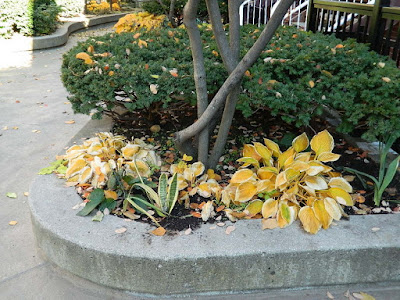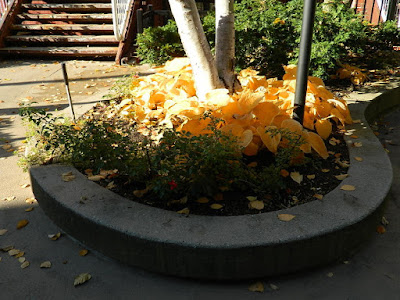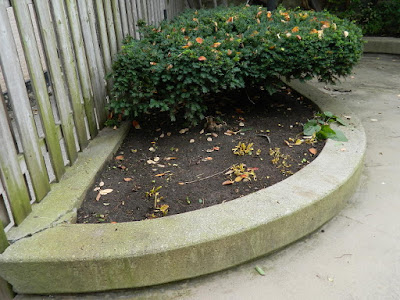A Fall Cleanup in a Downtown Toronto Courtyard
If you grow hostas in Toronto (and who doesn't, it seems), you knew this day would come. Your clumps of slug bait prized perennials have finally collapsed and on their way to becoming a slimy mess. What to do? Cut them down now or deal with the mess next spring? A perennial question, indeed.
Hostas have their virtues, don't get me wrong: they are practically indestructible in most soils with decent drainage, there are hundreds of varieties in the market and are useful in garden designs as specimens or "filler". I like to consider hostas as "perennials with training wheels" for newbies as they are often found for sale in the same places you'd pick up a can of paint or drywall, forgiving of abuse and relatively inexpensive. I certainly bought more than a few when I first started planting in my current garden decades ago.
So it's no surprise that I see hostas in many of the gardens I work in and, at this time of the year, I've been dealing with them almost daily during my fall cleanup sessions for clients. This post will yet again show hostas "melting" into winter dormancy which kind of describes my physical condition at the end of another work season!
If you like hostas and yews, you're in for a treat (sarcasm inserted). This condo courtyard profiled in this post (and in another post titled "Weeding Raised Beds in a Central Toronto Courtyard: Getting Gritty in Downtown Toronto") has a dozen or so curvilinear raised beds full of hostas and yews. The look of overall garden is firmly stuck in the mid 1980s:
 |
Toronto Garden District
Fall Cleanup Before |
 |
Toronto Garden District
Fall Cleanup Before |
 |
Garden District Courtyard Toronto
Fall Cleanup Before |
 |
Toronto Garden District
Courtyard Fall Cleanup Before |
 |
Garden District Toronto
Fall Cleanup Before |
 |
Garden District Toronto
Fall Cleanup Before |
 |
Toronto Garden District
Courtyard Fall Cleanup Before |
 |
Garden District Courtyard
Toronto Fall Cleanup Before |
It's a "mow-blow-go" landscape maintenance contractor's Nirvana (even better, there's no grass therefore no "mow" so you can "go" even quicker.) The work would simply consist of coming in with a few worker bees and shearing these yew meatballs and UFOs with gas-powered clippers, blowing away debris from the paths and getting back to the truck to check their phones and scoot on to their next job.
I was confused as to why the condo board would want to hire me to look after the courtyard area, given the monoculture of shorn evergreens and hostas, but apparently the board members wanted to update the plantings circa the late 1900s and are even considering removing some of the more contorted yews and replacing them with a greater variety of deciduous shrubs and perennials. And so they called me for this spring 2019 project.
But between now and warmer times in 5 months, a fall cleanup was booked and completed, as the pictures below show:
 |
Toronto Garden District
Fall Cleanup After |
 |
Toronto Garden District
Fall Cleanup After |
 |
Garden District Courtyard
Toronto Fall Cleanup After |
 |
Toronto Garden District
Courtyard Fall Cleanup After |
 |
Garden District Toronto
Fall Cleanup After |
 |
No, these are not yews surprisingly.
A "grove" of Fiveleaf Aralia (Eleutherococcus
( syn. Acanthopanax) sieboldianus).
|
 |
Toronto Garden District
Courtyard Fall Cleanup After |
 |
Garden District Courtyard
Toronto Fall Cleanup After |
On a positive and hopeful note, someone did plant this small clump of "Goldsturm" coneflower (Rudbeckia fulgida ‘Goldsturm’) below. I left it alone for the winter, an "oasis" for hungry overwintering birds within the barren yew-dominated courtyard.
 |
Garden District Courtyard Fall
Rudbeckia (Black Eye Susans) |

















No comments:
Post a Comment